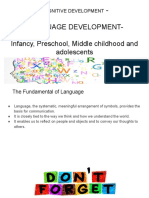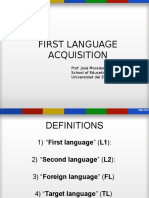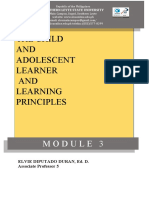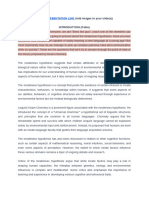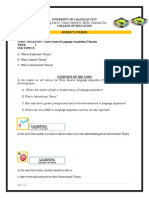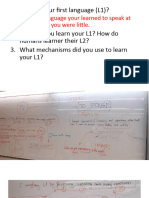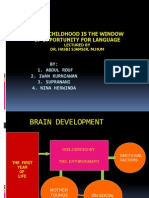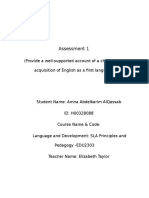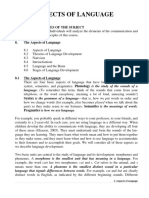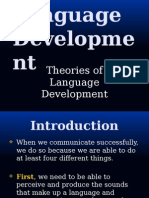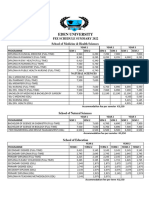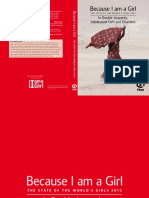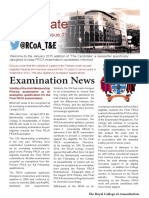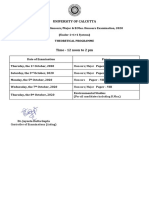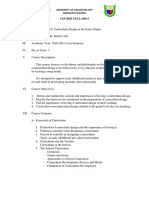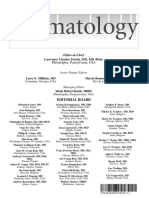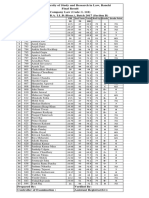THEORIES OF LANGUAGE
DEVELOPMENT
1. Nativist/Innate theory
2. Socio-linguistic theory
� Tutorial question
• Basing your argument on primary school
education, discuss how a teacher can develop
language skills in the classroom.
� OBJECTIVES
Students to be able to:
• give an overview of the given theories of
Language development.
• discuss the relevance of each theory of
language development, to teaching and
learning in the primary school.
• explain the importance of studying language
development by the primary school teachers.
� Definition of key terms
Language
• Is the term used to denote a system of
symbols that are used to communicate ideas
among people.
It is a systematic means of communication
that uses sounds or conventional symbols.
It is the socially shared code that represents
ideas through rules.
� Cont.
Language development/acquisition
• Is a process of acquiring language that starts
from infancy through crying and babbling,
which later translates to communication and
speech.
• It is the process by which people acquire the
capacity to perceive, produce & use words to
communicate.
� The universal language development
process
• The first language used by babies is in the
form of crying.
• At this stage, it is their means of
communicating hunger, pain, discomfort and
frustration.
• Later the baby makes cooing and babbling
sounds as a pre-speech process.
� continued
• These actions start off as unsystematic and
random, but later become more controlled and
frequently repeated (universal language).
• Children therefore, are said to acquire
language in the following stages:
� Cont’
age Language development process
0-3 months Crying as a reflexive communication
4-6 months Crying & unsystematic cooing
6-12 months Crying, cooing & systematic babbling
12-18 months First recognisable one word utterances
e.g. dada, mum
18-24 months Twenty words e.g. daddy, mummy, water,
orange etc.
24-48 months Multi-words. Two/ three word sentences.
Telegraphic in nature e.g. me
hungry/water drink.
48 months- Almost normal speech. Frequent use of
5years short sentences e.g. I am hungry
� Discussion Question
• If language development in children is said to
follow fixed age-related stages, why is it that
some children who are mature for school entry
have speech difficulties at school? (Infant
level).
�Universal characteristics of Language
a) As a system of symbols
• Most of the languages use symbols to refer to people, places,
events and objects.
• It is these symbols that make interaction possible.
b) As a system of rules
• Any language has rules that govern its usage.
• Words are combined in a systematic way to produce meaningful
sentences.
• It has structures/syntax (tenses, grammar, language register) that
have to be followed.
• It is therefore, these rules that make language to be
comprehensive to others.
� The Cognitive view to language
development
• Cognitivists believe that language is in-born in
humans.
• The acquisition and development of language is
linked to biological maturity and mental
development of an individual.
• Thoughts are a product of language.
• Language has rules that make it to be
comprehensive and meaningful to others.
• Language is used for communication purposes.
� Innate/ Nativist Theory of Language
Development
• Was propounded by Avram Noam Chomsky (American
linguist & philosopher).
• He states that humans are born with a built-in Language
Acquisition Device (LAD).
• This LAD is an innate neurological device that is
programmed to pick regular features of any language.
• He concluded that all humans have a predisposition for
universal grammar (UG) due to the availability of the
LAD.
• It is this LAD that makes it easy for children to develop or
acquire any language they are exposed to.
� Continued
• Chomsky therefore credits the LAD in its
stimulation of the UG that makes it possible
for children to acquire language.
• UG denotes the common building blocks that
all languages share e.g. having nouns, verbs,
adjectives, adverbs, prepositions.
• Note: Children also acquire or develop
language following the pattern, nouns-verbs-
adjectives-adverbs-prepositions.
� Cont’
• Chomsky stresses that children start to speak at
about the same age.
• By age five, they would have mastered most of the
grammatical patterns of language.
• He therefore, notes that there is a critical period of
acquiring language, i.e. from infancy to 12 years of
age.
• NB Although language is most critical and much
easier to acquire or develop at the above ages, it is
a lifelong process.
� Discussion Question
• Have you noticed that when you visit an area
that speaks a different language from yours,
young children in your company would be
able to speak that language in a short period of
time compared to you as an adult? What could
be the cause of this?
� Chomsky’s transformational language
structures
• Chomsky also noted that due to the influence of LAD,
children where able to interpret and construct novel language
structures that they would never have heard before.
• This made him to come up with two grammar structures that
he proposed are used by learners to develop a language.
• He named these as transformational language structures.
• They comprise of:
1. The deep structure.
2. The surface structure.
� Transformational grammar
a)The surface structure- refers to the simplest form of
expression that one can give e.g. My brother drives a red
car.
• However, this same sentence can be transformed to be:
The red car is being driven by my brother.
• The transformation made helps to develop language in
children/learners.
• They are able to convey what they see or think of in
different ways.
NOTE This allows one sentence to be expressed in a variety
of ways.
� Examples
ARTICLE ADJECTIVE NOUN ADVERB VERB ARTICLE ADJECTIVE N
The big car badly injured the mad m
was
The mad man badly injured by the big c
� Continued
b). The deep structure
• This refers to the more advanced and meaningful
way of expressing facts.
• The 2 sentences above: My brother drives a
red car and The red car is being driven by my
brother, can be further transformed.
• My brother drives a red car that was stolen
yesterday/ The red car that was being driven
by my brother was involved in an accident.
� Discussion Question
In a classroom set-up, which other common
language structures that learners use repeatedly
in their communication, which are in the surface
structure? Come up with different transformed
versions of these in both the surface and deep
structure.
� Implications to the teacher
• Knowledge of children’s innate capabilities (LAD) in language
development/acquisition is of paramount importance to the teacher.
• It assists the teacher to notice those learners who are lagging behind in
language development in order to offer them individualized assistance.
• Children come to school already having a language, so the teacher has
to build on it.
• Children have a potential to develop their own language and to acquire
any other, so a teacher has to stimulate their mental processes by
engaging them in practical language activities.
• Language structures are to be taught in context, not in isolation
(production & meaning).
• Teach infant learners language structures in the same pattern that they
naturally develop it. (nouns, verbs, adjectives, adverbs, prepositions)
� Cont’
• Use a variety of mind provoking activities that
allow for interaction, listening, reading and
writing of language structures.
• There is no limit to language structures that a
child can learn, therefore teachers are to provide
many opportunities for practice (drama,
roleplay, narratives, dialogues, compositions etc.
• Teachers to be role models and use the correct
language structures when communicating.
� Cont’
• Learners are allowed to learn from their mistakes,
without any ridicule or punishment.
e.g. for grammar errors, the teacher to model the
correct language structure which will be repeated or
practiced by learners.
• Teachers are to avoid using language that is beyond the
learners’ comprehension, when explaining concepts.
• Teachers to capitalize on the learners’ critical period of
language development, to maximize on their innate
capabilities.
� Critique
• The LAD concept in humans is an abstract
phenomenon that has no empirical evidence..
• Relying on the LAD alone, without
environmental influence is not enough to
explain the language acquisition process.



